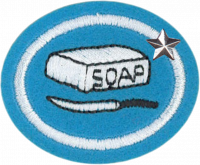AY Honors/Soap Craft - Advanced/Answer Key
Skill Level
2
Year
1964
Version
22.12.2024
Approval authority
North American Division
1
For tips and instruction see Soap Craft.
2
Any fat that can undergo saponification can be used for making soap. Saponifiables are components of an oily (oil, fat, wax) mixture that form soaps when blended with lye.
3
Transparent soap can be made by re-melting a batch of regular, opaque soap and adding alcohol and glycerin to it. The alcohol reduces the size of the crystals that form as the soap cools, and when these crystals are small enough, they will no longer reflect light. Rather, the light will easily pass between them and the soap will appear transparent.
4
| Advantages | Disadvantages | |
|---|---|---|
| Soap |
|
|
| Detergent |
|
|
5
- Abrasives
- Gritty substances are added to soap to help it scrub away dirt. There are many abrasives that are used as soap additives including:
- Almond meal
- Bran
- Cinnamon
- Cornmeal
- Oatmeal
- Pumice (volcanic rock)
- Sand
- Wheat germ
- Cleansers
- A cleanser is used used to remove make-up, dead skin cells, oil, dirt and other types of pollutants from the skin of the face. This helps to unclog pores and prevent skin conditions such as acne. Some additives that act as cleansers include:
- Cucumber
- Milk (cow, goat, etc.)
- Witch hazel
- Emollients
- Emollients are substances that soften and soothe the skin. They are used to correct dryness and scaling of the skin. Additives that act as emollients include:
- Honey
- Glycerin
- Lanolin
- Rose water
- Antibacterials
- These additives kill bacteria. Additives that act as antibacterial include:
- Lemon
- Myrrh
- Sage
6
Floating soaps (such as Ivory) have had air whipped into them when they were in liquid form. The air bubbles reduce the density of the final product making it lighter than an equal volume of water. Any substance that is lighter than an equal volume of water will float on water.
7
Stearic acid is the primary soap hardener, but several additives have that effect (to a lesser degree) as well including:
- Salt
- Cocoa butter
- Sodium lactate
8
Although you wash yourself with soda
- and use an abundance of soap,
- the stain of your guilt is still before me,"
- declares the Sovereign LORD.
But who can endure the day of his coming? Who can stand when he appears? For he will be like a refiner's fire or a launderer's soap.
9
The two primary methods of making soap are the hot process and the cold process. In both cold-process and hot-process soapmaking, heat may be required for saponification.
Cold-process soapmaking takes place at a sufficient temperature to ensure the liquification of the fat being used. The lye and fat may be kept warm after mixing to ensure that the soap is completely saponified.
Unlike cold-processed soap, hot-processed soap can be used right away because lye and fat saponify more quickly at the higher temperatures used in hot-process soapmaking.
Hot-process soapmaking was used when the purity of lye was unreliable, and this process can use natural lye solutions, such as potash. The main benefit of hot processing is that the exact concentration of the lye solution does not need to be known to perform the process with adequate success.
Cold-process soapmaking requires exact measurements of lye and fat amounts and computing their ratio, using saponification charts to ensure that the finished product is mild and skin-friendly. Saponification charts can also be used in hot-process soapmaking, but are not as necessary as in cold-process soapmaking.
The recipe detailed below is a cold-process method.
Re-edited info from Do-It-Yourself/Soap on WikiBooks.
Making soap
Equipment
- Any sort of animal or vegetable fat.
- Sodium Hydroxide (NaOH), also known as lye.
- Glass beaker and stirring rod.
- Bunsen burner or other means of heating solution.
- Mold for making soap bars (any flexible plastic container).
- Vinegar, just in case.
| SAFETY NOTES |
|
| SAFETY NOTES |
What to do
- Place 16 oz. of any fat, such as oil or butter in a beaker.
- In another container add 2.1 oz. (59.5 g) of Sodium Hydroxide (NaOH) to 6 oz. (170g) of water (do not add water to Sodium Hydroxide (NaOH) - it will splatter) stir to dissolve and let cool to 110 F.
- Melt fat under low heat to 110°F (49°C) and add the Sodium Hydroxide (NaOH) solution while stirring until the base has completely reacted with the fat (about 20 to 30 minutes)
- Pour the mixture into molds.
- Let this cool and sit for a day or two. Let the soap cakes cure for three weeks before using.
Additional Soapmaking References
- History and Process of Soap Making
- Cold process for Soapmaking
- Melt and Pour process for Soapmaking
- Rebatching technique
10
10a
You can visit a commercial manufacturer of soaps or find a soap-making school near you.
10b
Back when this honor was first developed, it was assumed that you would probably write a letter to a soapmaker to obtain this information. Soapmakers would have information packets that they would send out in response. These days however, they put this information online. Here are a few websites with this type of information:
10c
The Wikipedia article on Soap is an excellent resource for this.


